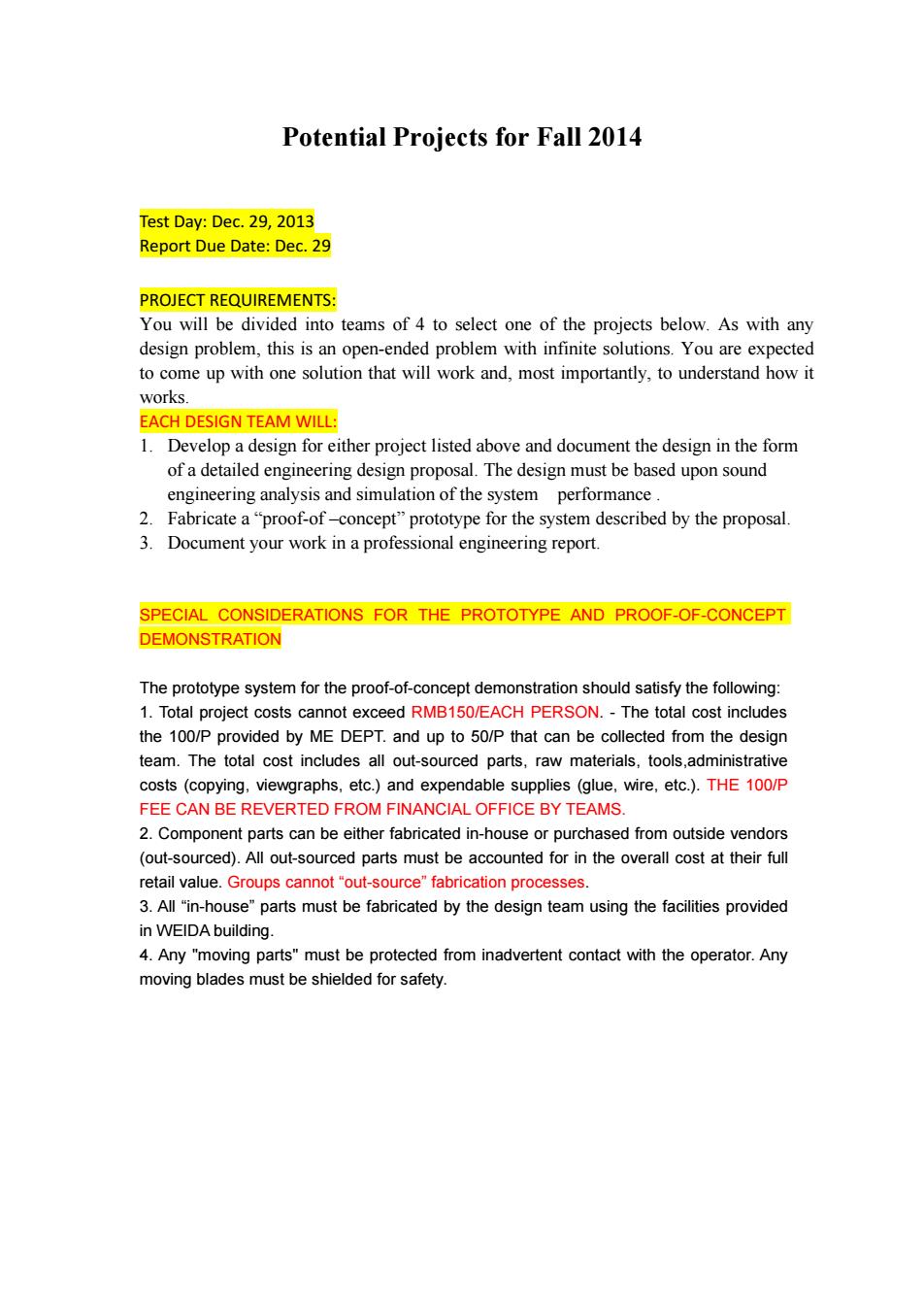
Potential Projects for Fall 2014 Test Day:Dec.29,2013 Report Due Date:Dec.29 PROJECT REQUIREMENTS: You will be divided into teams of 4 to select one of the projects below.As with any design problem,this is an open-ended problem with infinite solutions.You are expected to come up with one solution that will work and,most importantly,to understand how it works. EACH DESIGN TEAM WILL: 1.Develop a design for either project listed above and document the design in the form of a detailed engineering design proposal.The design must be based upon sound engineering analysis and simulation of the system performance. 2.Fabricate a"proof-of-concept"prototype for the system described by the proposal. 3.Document your work in a professional engineering report SPECIAL CONSIDERATIONS FOR THE PROTOTYPE AND PROOF-OF-CONCEPT DEMONSTRATION The prototype system for the proof-of-concept demonstration should satisfy the following: 1.Total project costs cannot exceed RMB150/EACH PERSON.The total cost includes the 100/P provided by ME DEPT.and up to 50/P that can be collected from the design team.The total cost includes all out-sourced parts,raw materials,tools,administrative costs (copying,viewgraphs,etc.)and expendable supplies (glue,wire,etc.).THE 100/P FEE CAN BE REVERTED FROM FINANCIAL OFFICE BY TEAMS. 2.Component parts can be either fabricated in-house or purchased from outside vendors (out-sourced).All out-sourced parts must be accounted for in the overall cost at their full retail value.Groups cannot "out-source"fabrication processes. 3.All "in-house"parts must be fabricated by the design team using the facilities provided in WEIDA building. 4.Any "moving parts"must be protected from inadvertent contact with the operator.Any moving blades must be shielded for safety
Potential Projects for Fall 2014 Test Day: Dec. 29, 2013 Report Due Date: Dec. 29 PROJECT REQUIREMENTS: You will be divided into teams of 4 to select one of the projects below. As with any design problem, this is an open-ended problem with infinite solutions. You are expected to come up with one solution that will work and, most importantly, to understand how it works. EACH DESIGN TEAM WILL: 1. Develop a design for either project listed above and document the design in the form of a detailed engineering design proposal. The design must be based upon sound engineering analysis and simulation of the system performance . 2. Fabricate a “proof-of –concept” prototype for the system described by the proposal. 3. Document your work in a professional engineering report. SPECIAL CONSIDERATIONS FOR THE PROTOTYPE AND PROOF-OF-CONCEPT DEMONSTRATION The prototype system for the proof-of-concept demonstration should satisfy the following: 1. Total project costs cannot exceed RMB150/EACH PERSON. - The total cost includes the 100/P provided by ME DEPT. and up to 50/P that can be collected from the design team. The total cost includes all out-sourced parts, raw materials, tools,administrative costs (copying, viewgraphs, etc.) and expendable supplies (glue, wire, etc.). THE 100/P FEE CAN BE REVERTED FROM FINANCIAL OFFICE BY TEAMS. 2. Component parts can be either fabricated in-house or purchased from outside vendors (out-sourced). All out-sourced parts must be accounted for in the overall cost at their full retail value. Groups cannot “out-source” fabrication processes. 3. All “in-house” parts must be fabricated by the design team using the facilities provided in WEIDA building. 4. Any "moving parts" must be protected from inadvertent contact with the operator. Any moving blades must be shielded for safety
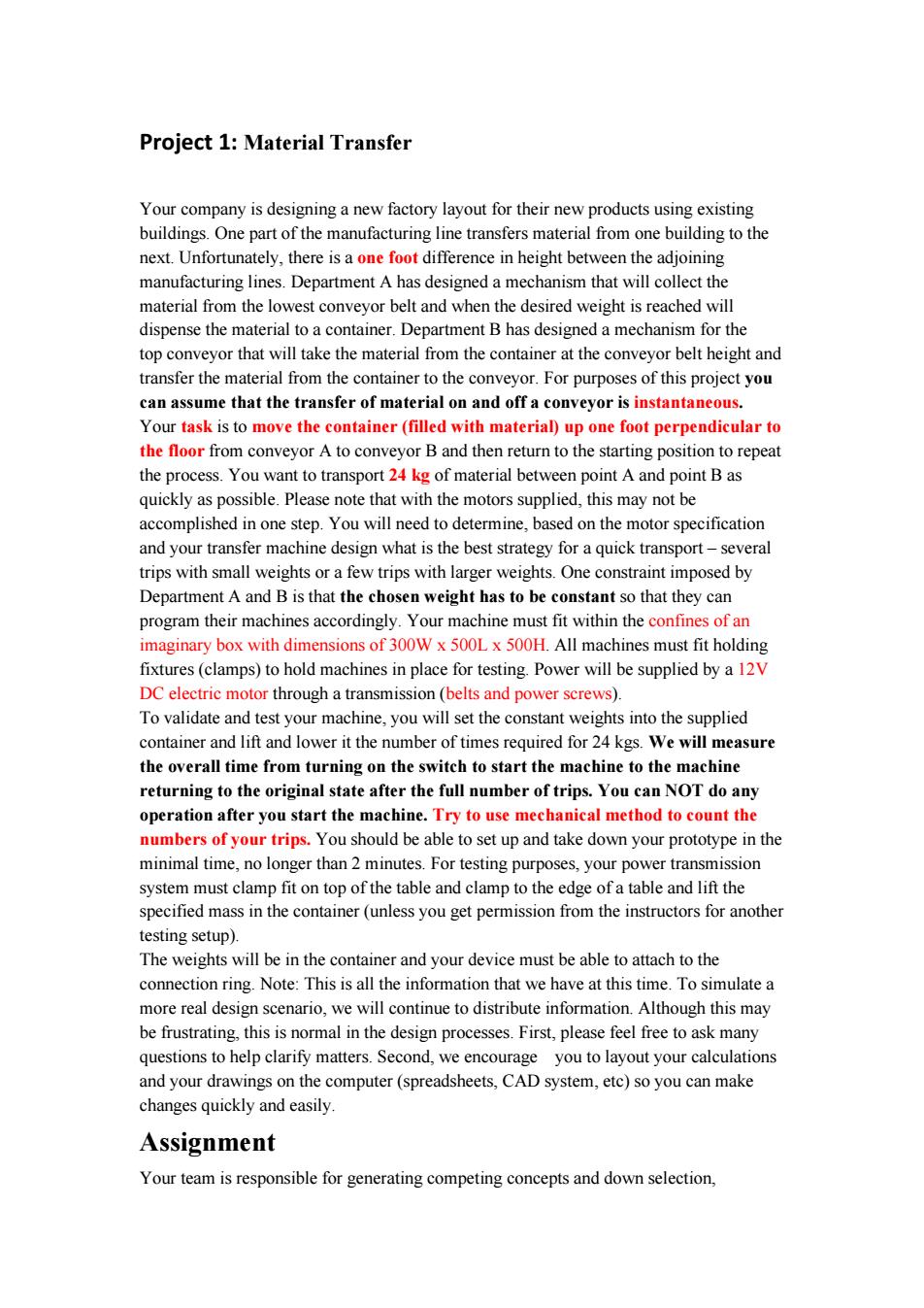
Project 1:Material Transfer Your company is designing a new factory layout for their new products using existing buildings.One part of the manufacturing line transfers material from one building to the next.Unfortunately,there is a one foot difference in height between the adjoining manufacturing lines.Department A has designed a mechanism that will collect the material from the lowest conveyor belt and when the desired weight is reached will dispense the material to a container.Department B has designed a mechanism for the top conveyor that will take the material from the container at the conveyor belt height and transfer the material from the container to the conveyor.For purposes of this project you can assume that the transfer of material on and off a conveyor is instantaneous. Your task is to move the container(filled with material)up one foot perpendicular to the floor from conveyor A to conveyor B and then return to the starting position to repeat the process.You want to transport 24 kg of material between point A and point B as quickly as possible.Please note that with the motors supplied,this may not be accomplished in one step.You will need to determine.based on the motor specification and your transfer machine design what is the best strategy for a quick transport-several trips with small weights or a few trips with larger weights.One constraint imposed by Department A and B is that the chosen weight has to be constant so that they can program their machines accordingly.Your machine must fit within the confines of an imaginary box with dimensions of 300W x 500L x 500H.All machines must fit holding fixtures(clamps)to hold machines in place for testing.Power will be supplied by a 12V DC electric motor through a transmission(belts and power screws). To validate and test your machine,you will set the constant weights into the supplied container and lift and lower it the number of times required for 24 kgs.We will measure the overall time from turning on the switch to start the machine to the machine returning to the original state after the full number of trips.You can NOT do any operation after you start the machine.Try to use mechanical method to count the numbers of your trips.You should be able to set up and take down your prototype in the minimal time,no longer than 2 minutes.For testing purposes,your power transmission system must clamp fit on top of the table and clamp to the edge of a table and lift the specified mass in the container(unless you get permission from the instructors for another testing setup). The weights will be in the container and your device must be able to attach to the connection ring.Note:This is all the information that we have at this time.To simulate a more real design scenario,we will continue to distribute information.Although this may be frustrating,this is normal in the design processes.First,please feel free to ask many questions to help clarify matters.Second,we encourage you to layout your calculations and your drawings on the computer(spreadsheets,CAD system,etc)so you can make changes quickly and easily. Assignment Your team is responsible for generating competing concepts and down selection
Project 1: Material Transfer Your company is designing a new factory layout for their new products using existing buildings. One part of the manufacturing line transfers material from one building to the next. Unfortunately, there is a one foot difference in height between the adjoining manufacturing lines. Department A has designed a mechanism that will collect the material from the lowest conveyor belt and when the desired weight is reached will dispense the material to a container. Department B has designed a mechanism for the top conveyor that will take the material from the container at the conveyor belt height and transfer the material from the container to the conveyor. For purposes of this project you can assume that the transfer of material on and off a conveyor is instantaneous. Your task is to move the container (filled with material) up one foot perpendicular to the floor from conveyor A to conveyor B and then return to the starting position to repeat the process. You want to transport 24 kg of material between point A and point B as quickly as possible. Please note that with the motors supplied, this may not be accomplished in one step. You will need to determine, based on the motor specification and your transfer machine design what is the best strategy for a quick transport – several trips with small weights or a few trips with larger weights. One constraint imposed by Department A and B is that the chosen weight has to be constant so that they can program their machines accordingly. Your machine must fit within the confines of an imaginary box with dimensions of 300W x 500L x 500H. All machines must fit holding fixtures (clamps) to hold machines in place for testing. Power will be supplied by a 12V DC electric motor through a transmission (belts and power screws). To validate and test your machine, you will set the constant weights into the supplied container and lift and lower it the number of times required for 24 kgs. We will measure the overall time from turning on the switch to start the machine to the machine returning to the original state after the full number of trips. You can NOT do any operation after you start the machine. Try to use mechanical method to count the numbers of your trips. You should be able to set up and take down your prototype in the minimal time, no longer than 2 minutes. For testing purposes, your power transmission system must clamp fit on top of the table and clamp to the edge of a table and lift the specified mass in the container (unless you get permission from the instructors for another testing setup). The weights will be in the container and your device must be able to attach to the connection ring. Note: This is all the information that we have at this time. To simulate a more real design scenario, we will continue to distribute information. Although this may be frustrating, this is normal in the design processes. First, please feel free to ask many questions to help clarify matters. Second, we encourage you to layout your calculations and your drawings on the computer (spreadsheets, CAD system, etc) so you can make changes quickly and easily. Assignment Your team is responsible for generating competing concepts and down selection
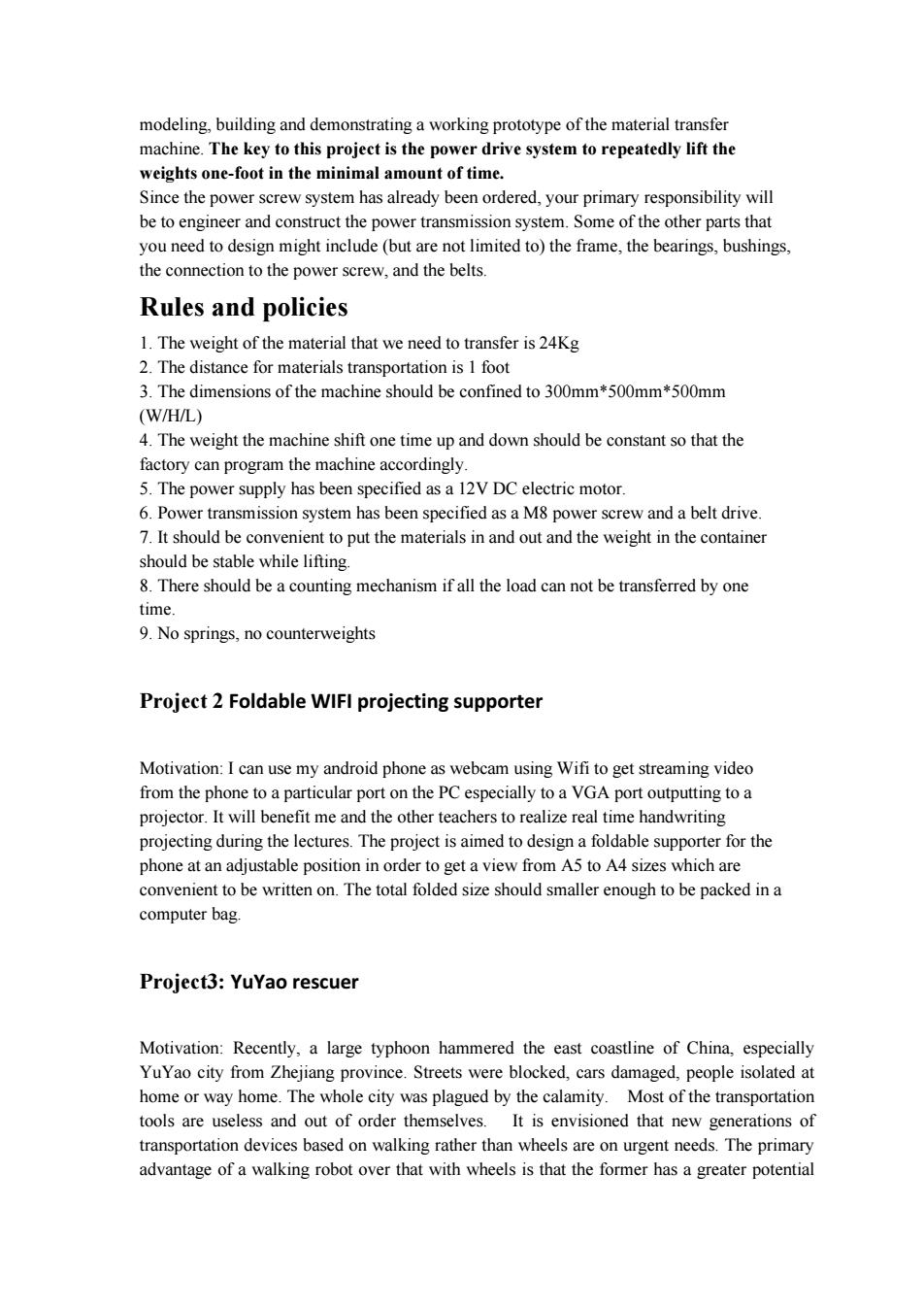
modeling,building and demonstrating a working prototype of the material transfer machine.The key to this project is the power drive system to repeatedly lift the weights one-foot in the minimal amount of time. Since the power screw system has already been ordered,your primary responsibility will be to engineer and construct the power transmission system.Some of the other parts that you need to design might include(but are not limited to)the frame,the bearings,bushings. the connection to the power screw,and the belts. Rules and policies 1.The weight of the material that we need to transfer is 24Kg 2.The distance for materials transportation is 1 foot 3.The dimensions of the machine should be confined to 300mm*500mm*500mm (W/H/L) 4.The weight the machine shift one time up and down should be constant so that the factory can program the machine accordingly. 5.The power supply has been specified as a 12V DC electric motor. 6.Power transmission system has been specified as a M8 power screw and a belt drive. 7.It should be convenient to put the materials in and out and the weight in the container should be stable while lifting 8.There should be a counting mechanism if all the load can not be transferred by one time. 9.No springs,no counterweights Project 2 Foldable WIFI projecting supporter Motivation:I can use my android phone as webcam using Wifi to get streaming video from the phone to a particular port on the PC especially to a VGA port outputting to a projector.It will benefit me and the other teachers to realize real time handwriting projecting during the lectures.The project is aimed to design a foldable supporter for the phone at an adjustable position in order to get a view from A5 to A4 sizes which are convenient to be written on.The total folded size should smaller enough to be packed in a computer bag. Project3:YuYao rescuer Motivation:Recently,a large typhoon hammered the east coastline of China,especially YuYao city from Zhejiang province.Streets were blocked,cars damaged,people isolated at home or way home.The whole city was plagued by the calamity.Most of the transportation tools are useless and out of order themselves.It is envisioned that new generations of transportation devices based on walking rather than wheels are on urgent needs.The primary advantage of a walking robot over that with wheels is that the former has a greater potential
modeling, building and demonstrating a working prototype of the material transfer machine. The key to this project is the power drive system to repeatedly lift the weights one-foot in the minimal amount of time. Since the power screw system has already been ordered, your primary responsibility will be to engineer and construct the power transmission system. Some of the other parts that you need to design might include (but are not limited to) the frame, the bearings, bushings, the connection to the power screw, and the belts. Rules and policies 1. The weight of the material that we need to transfer is 24Kg 2. The distance for materials transportation is 1 foot 3. The dimensions of the machine should be confined to 300mm*500mm*500mm (W/H/L) 4. The weight the machine shift one time up and down should be constant so that the factory can program the machine accordingly. 5. The power supply has been specified as a 12V DC electric motor. 6. Power transmission system has been specified as a M8 power screw and a belt drive. 7. It should be convenient to put the materials in and out and the weight in the container should be stable while lifting. 8. There should be a counting mechanism if all the load can not be transferred by one time. 9. No springs, no counterweights Project 2 Foldable WIFI projecting supporter Motivation: I can use my android phone as webcam using Wifi to get streaming video from the phone to a particular port on the PC especially to a VGA port outputting to a projector. It will benefit me and the other teachers to realize real time handwriting projecting during the lectures. The project is aimed to design a foldable supporter for the phone at an adjustable position in order to get a view from A5 to A4 sizes which are convenient to be written on. The total folded size should smaller enough to be packed in a computer bag. Project3: YuYao rescuer Motivation: Recently, a large typhoon hammered the east coastline of China, especially YuYao city from Zhejiang province. Streets were blocked, cars damaged, people isolated at home or way home. The whole city was plagued by the calamity. Most of the transportation tools are useless and out of order themselves. It is envisioned that new generations of transportation devices based on walking rather than wheels are on urgent needs. The primary advantage of a walking robot over that with wheels is that the former has a greater potential
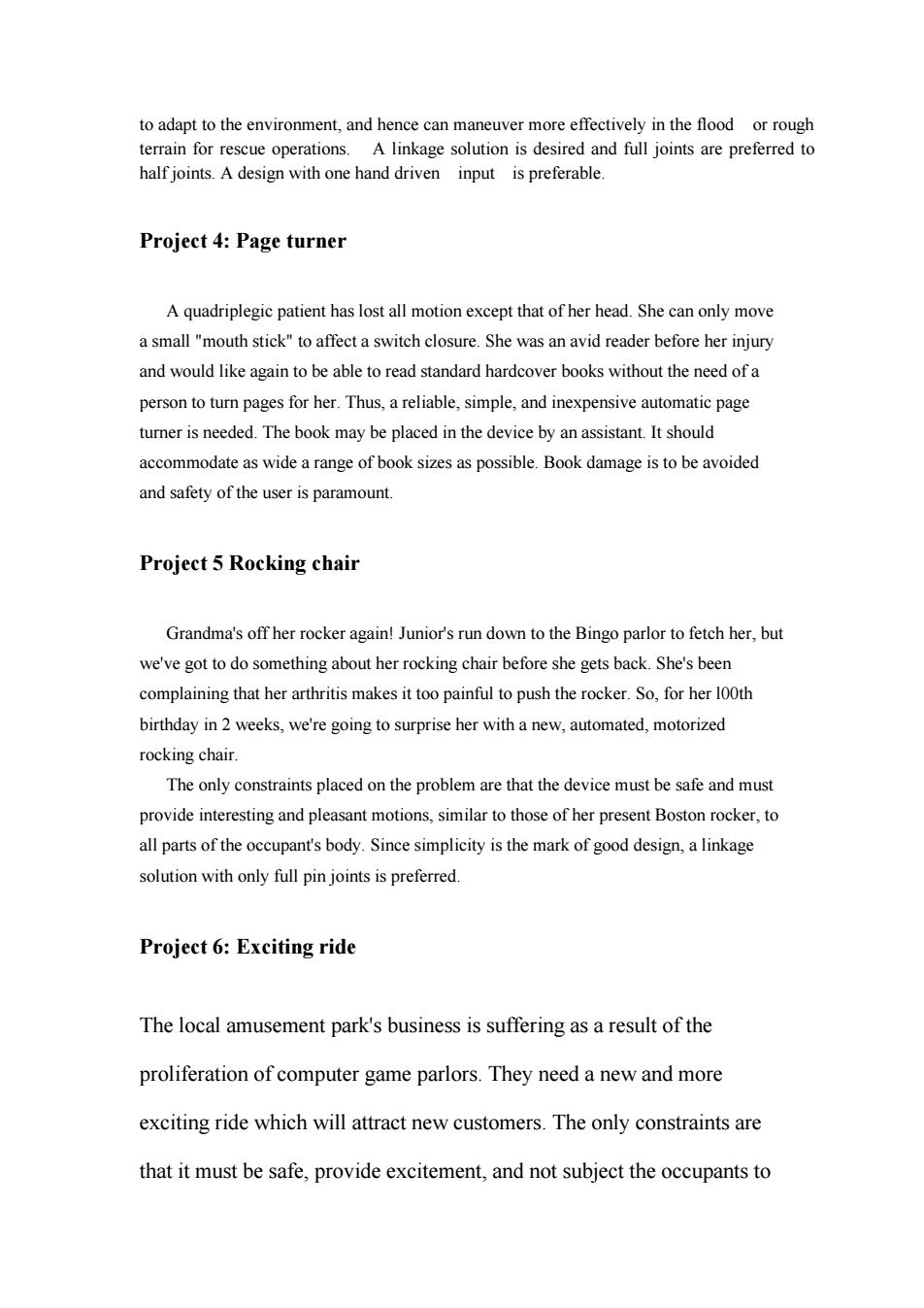
to adapt to the environment,and hence can maneuver more effectively in the flood or rough terrain for rescue operations.A linkage solution is desired and full joints are preferred to half joints.A design with one hand driven input is preferable. Project 4:Page turner A quadriplegic patient has lost all motion except that of her head.She can only move a small "mouth stick"to affect a switch closure.She was an avid reader before her injury and would like again to be able to read standard hardcover books without the need of a person to turn pages for her.Thus,a reliable,simple,and inexpensive automatic page turner is needed.The book may be placed in the device by an assistant.It should accommodate as wide a range of book sizes as possible.Book damage is to be avoided and safety of the user is paramount. Project 5 Rocking chair Grandma's off her rocker again!Junior's run down to the Bingo parlor to fetch her,but we've got to do something about her rocking chair before she gets back.She's been complaining that her arthritis makes it too painful to push the rocker.So,for her 100th birthday in 2 weeks,we're going to surprise her with a new,automated,motorized rocking chair. The only constraints placed on the problem are that the device must be safe and must provide interesting and pleasant motions,similar to those of her present Boston rocker,to all parts of the occupant's body.Since simplicity is the mark of good design,a linkage solution with only full pin joints is preferred. Project 6:Exciting ride The local amusement park's business is suffering as a result of the proliferation of computer game parlors.They need a new and more exciting ride which will attract new customers.The only constraints are that it must be safe,provide excitement,and not subject the occupants to
to adapt to the environment, and hence can maneuver more effectively in the flood or rough terrain for rescue operations. A linkage solution is desired and full joints are preferred to half joints. A design with one hand driven input is preferable. Project 4: Page turner A quadriplegic patient has lost all motion except that of her head. She can only move a small "mouth stick" to affect a switch closure. She was an avid reader before her injury and would like again to be able to read standard hardcover books without the need of a person to turn pages for her. Thus, a reliable, simple, and inexpensive automatic page turner is needed. The book may be placed in the device by an assistant. It should accommodate as wide a range of book sizes as possible. Book damage is to be avoided and safety of the user is paramount. Project 5 Rocking chair Grandma's off her rocker again! Junior's run down to the Bingo parlor to fetch her, but we've got to do something about her rocking chair before she gets back. She's been complaining that her arthritis makes it too painful to push the rocker. So, for her l00th birthday in 2 weeks, we're going to surprise her with a new, automated, motorized rocking chair. The only constraints placed on the problem are that the device must be safe and must provide interesting and pleasant motions, similar to those of her present Boston rocker, to all parts of the occupant's body. Since simplicity is the mark of good design, a linkage solution with only full pin joints is preferred. Project 6: Exciting ride The local amusement park's business is suffering as a result of the proliferation of computer game parlors. They need a new and more exciting ride which will attract new customers. The only constraints are that it must be safe, provide excitement, and not subject the occupants to
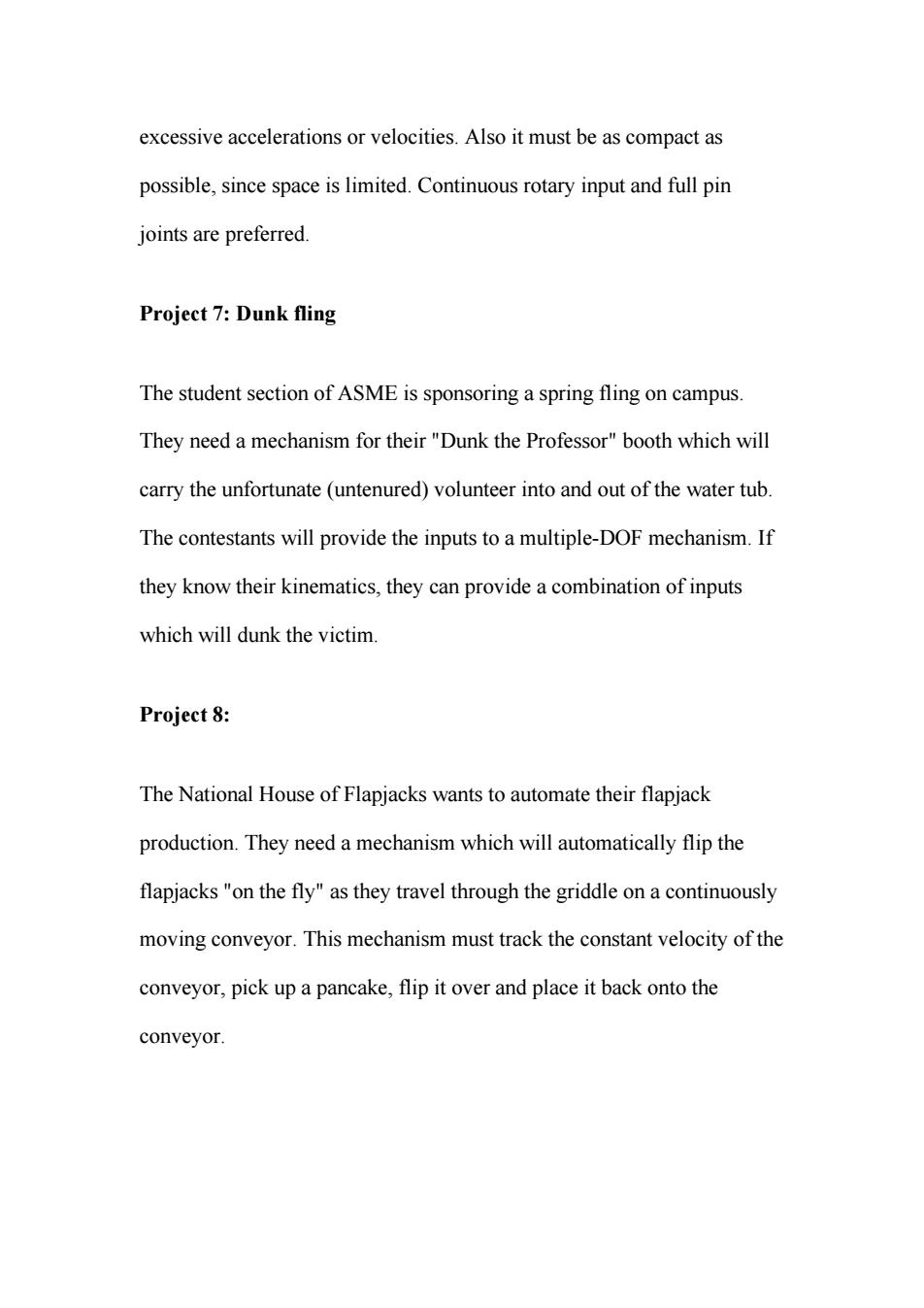
excessive accelerations or velocities.Also it must be as compact as possible,since space is limited.Continuous rotary input and full pin joints are preferred. Project 7:Dunk fling The student section of ASME is sponsoring a spring fling on campus. They need a mechanism for their"Dunk the Professor"booth which will carry the unfortunate (untenured)volunteer into and out of the water tub. The contestants will provide the inputs to a multiple-DOF mechanism.If they know their kinematics,they can provide a combination of inputs which will dunk the victim. Project 8: The National House of Flapjacks wants to automate their flapjack production.They need a mechanism which will automatically flip the flapjacks"on the fly"as they travel through the griddle on a continuously moving conveyor.This mechanism must track the constant velocity of the conveyor,pick up a pancake,flip it over and place it back onto the conveyor
excessive accelerations or velocities. Also it must be as compact as possible, since space is limited. Continuous rotary input and full pin joints are preferred. Project 7: Dunk fling The student section of ASME is sponsoring a spring fling on campus. They need a mechanism for their "Dunk the Professor" booth which will carry the unfortunate (untenured) volunteer into and out of the water tub. The contestants will provide the inputs to a multiple-DOF mechanism. If they know their kinematics, they can provide a combination of inputs which will dunk the victim. Project 8: The National House of Flapjacks wants to automate their flapjack production. They need a mechanism which will automatically flip the flapjacks "on the fly" as they travel through the griddle on a continuously moving conveyor. This mechanism must track the constant velocity of the conveyor, pick up a pancake, flip it over and place it back onto the conveyor